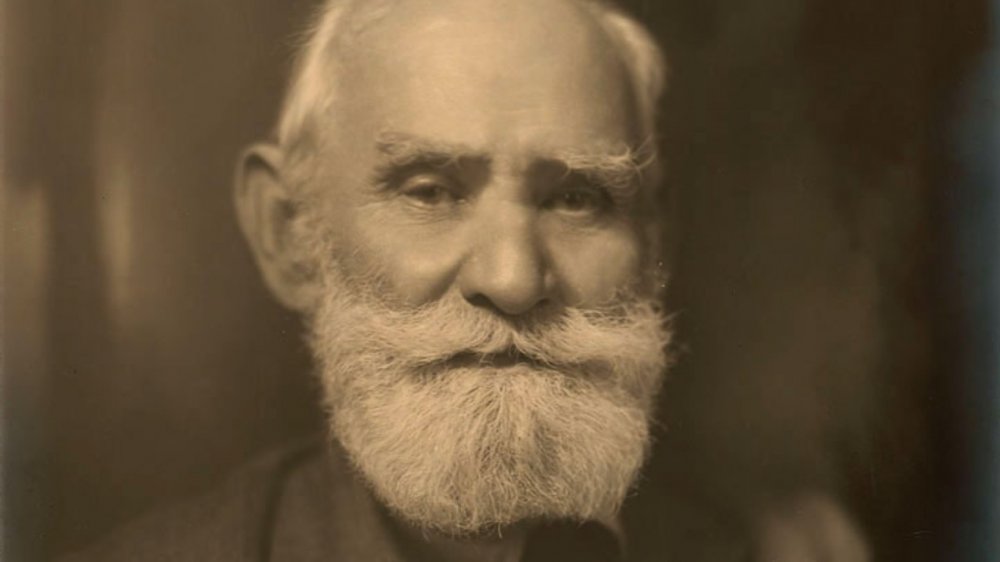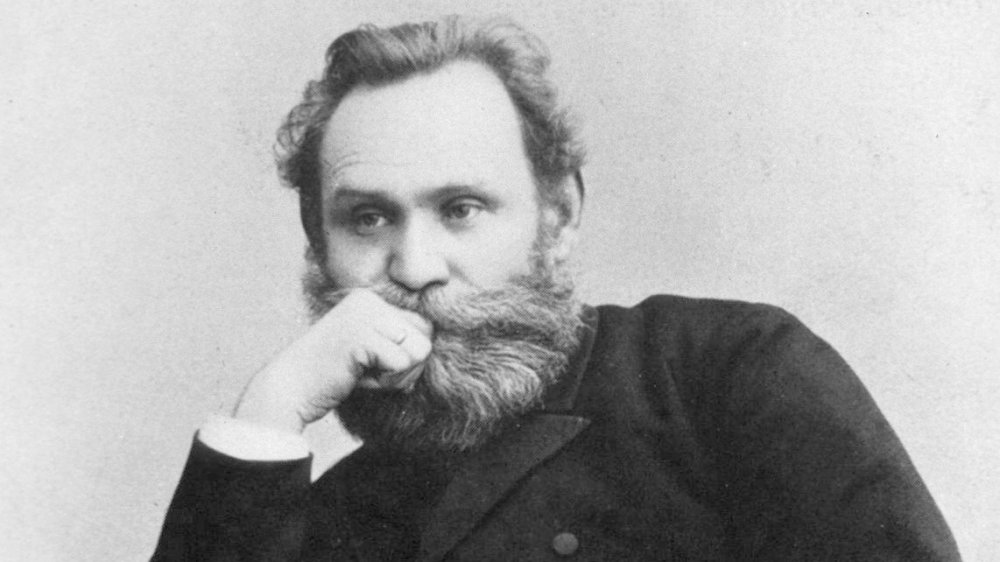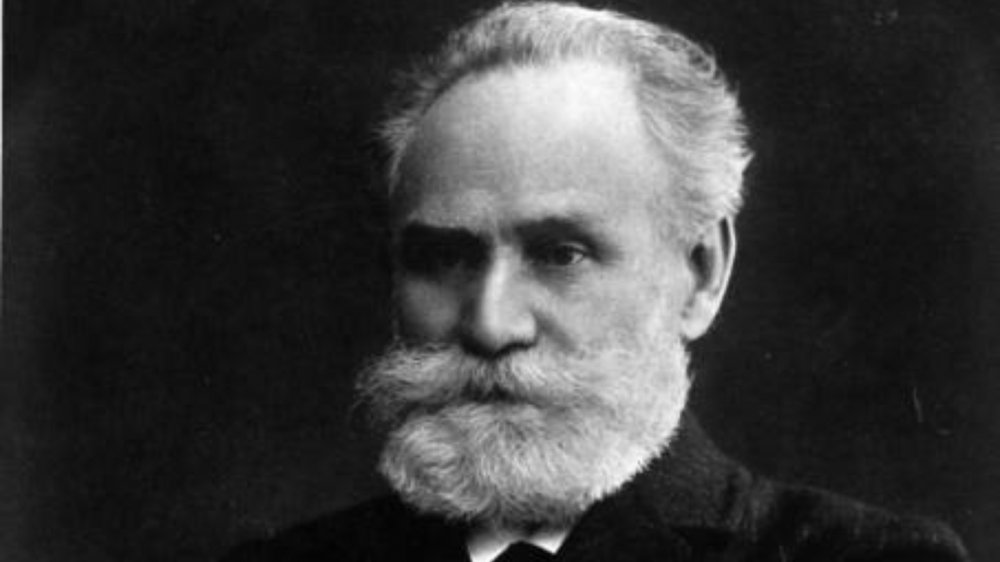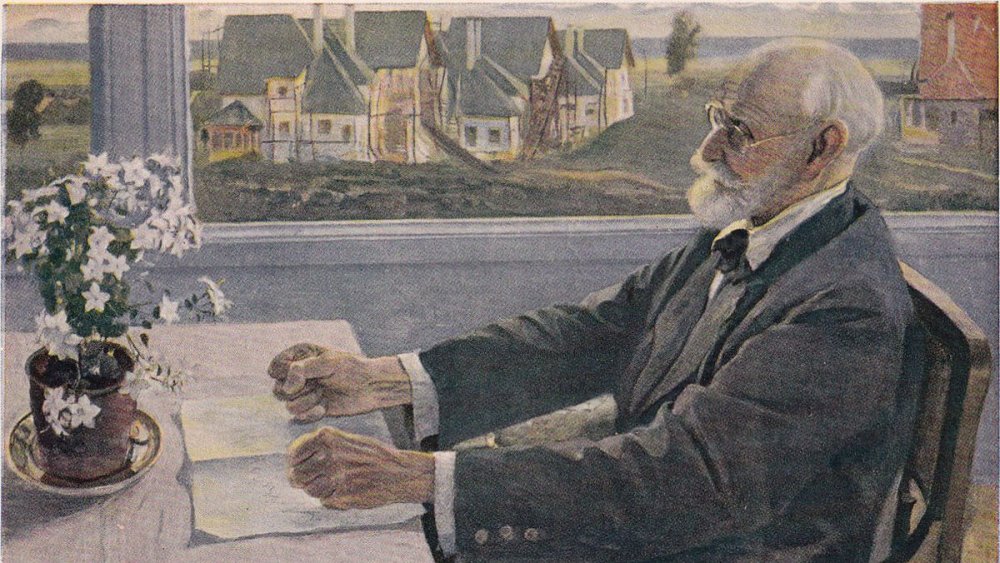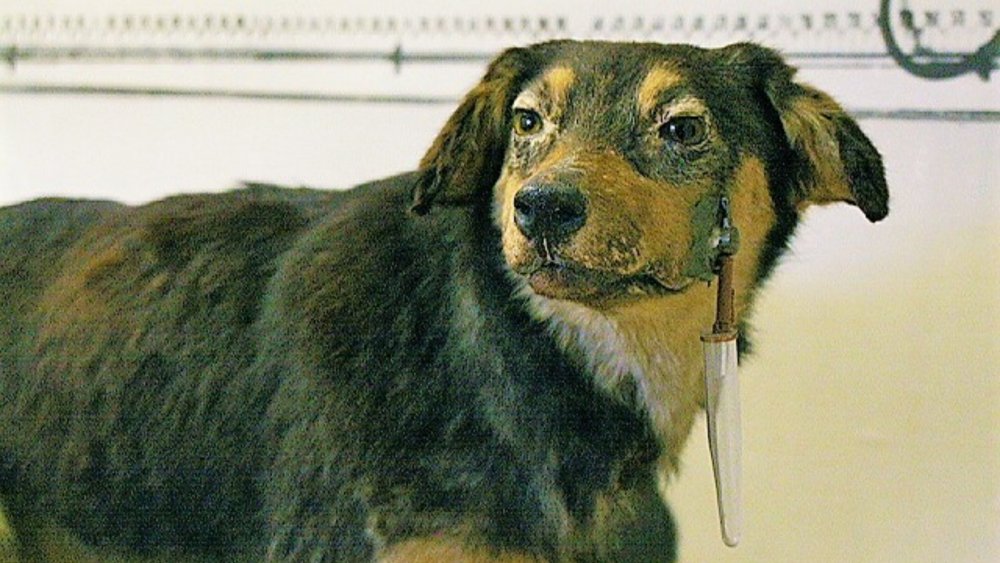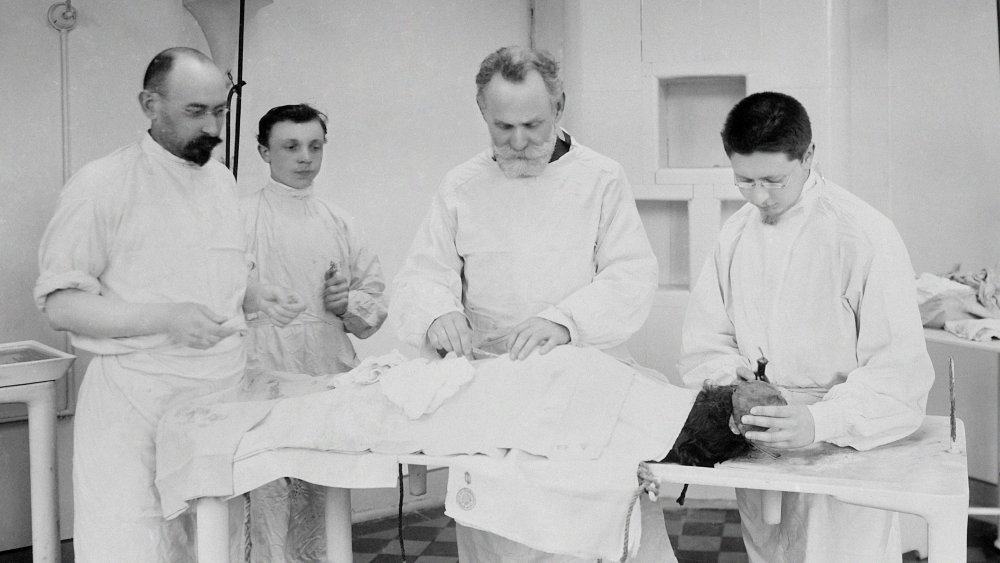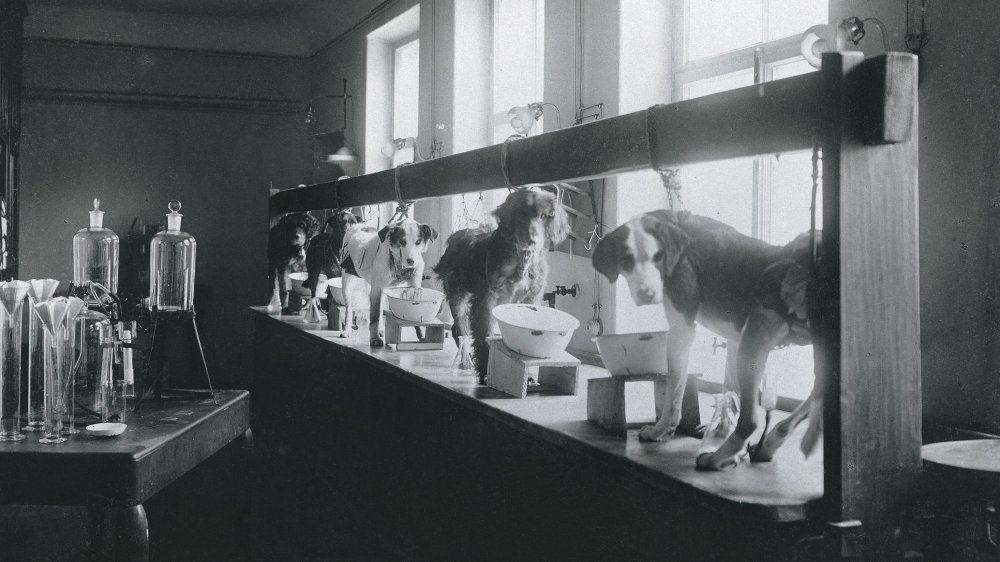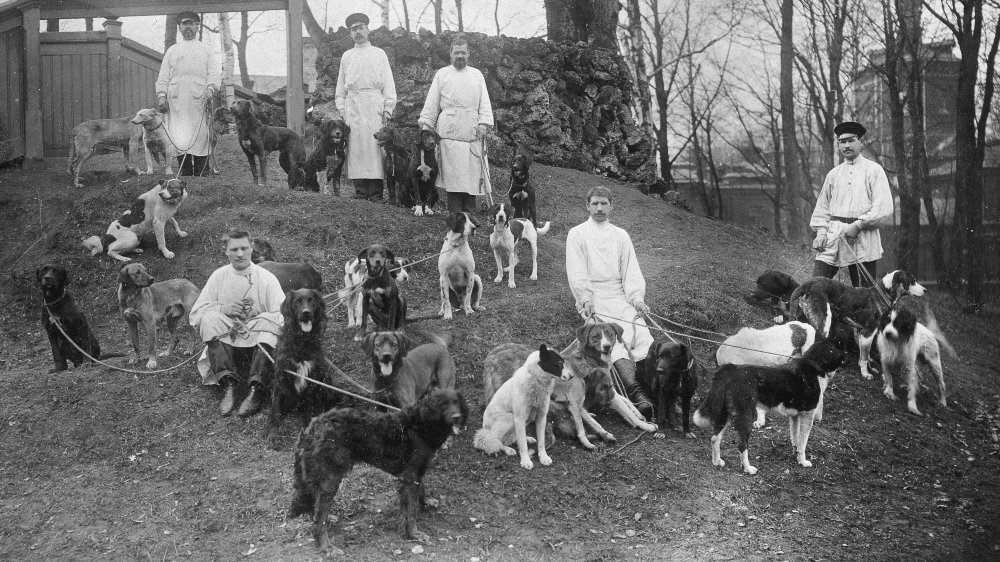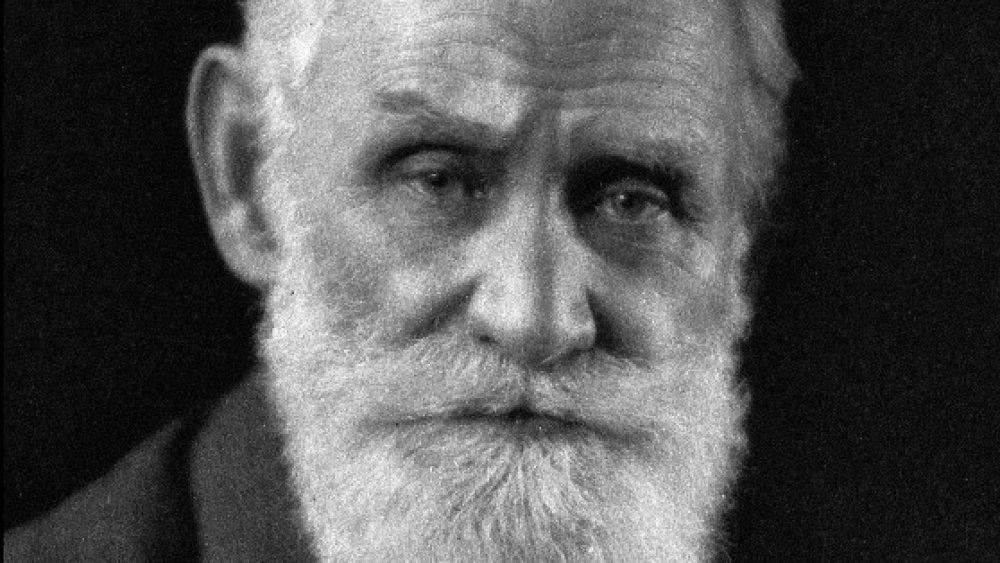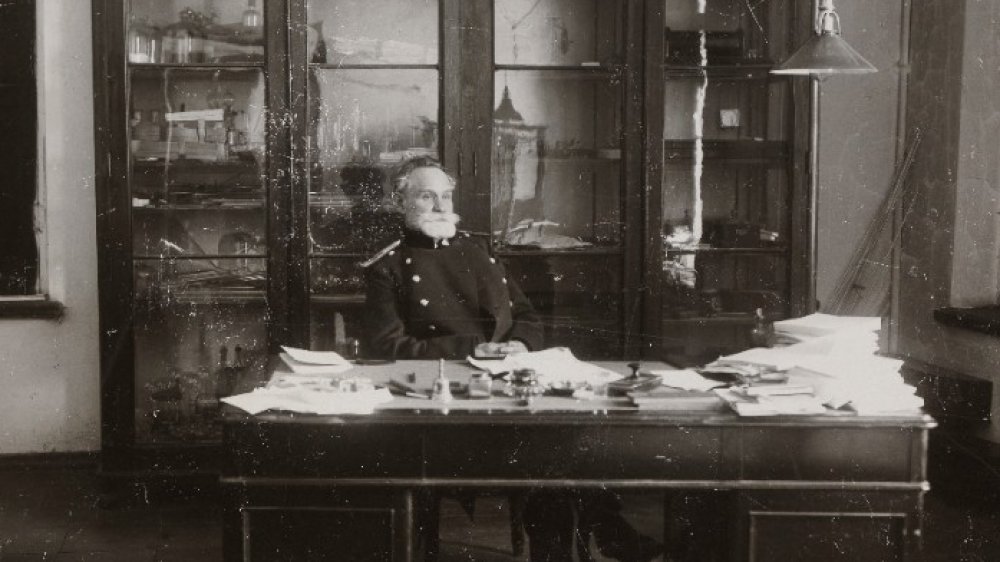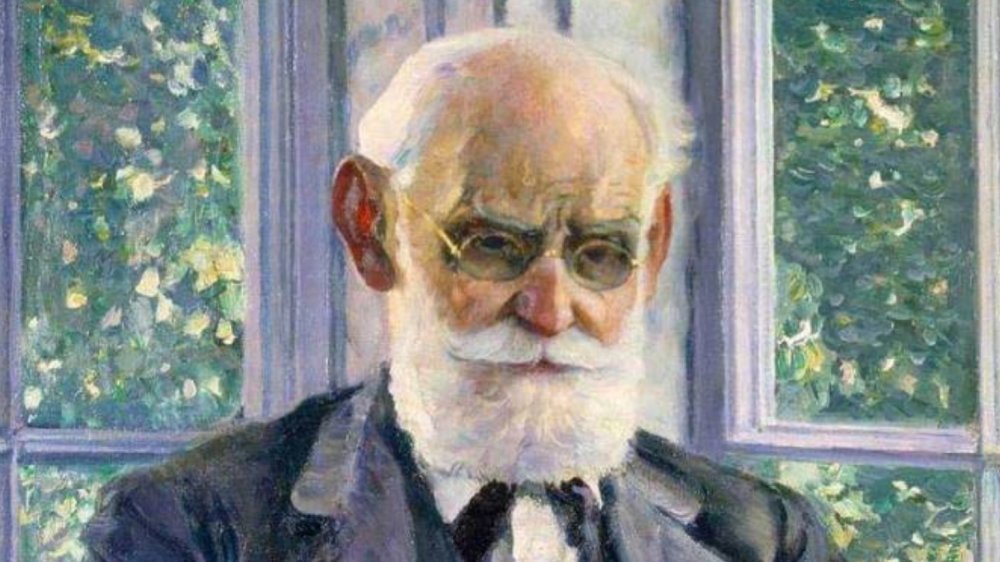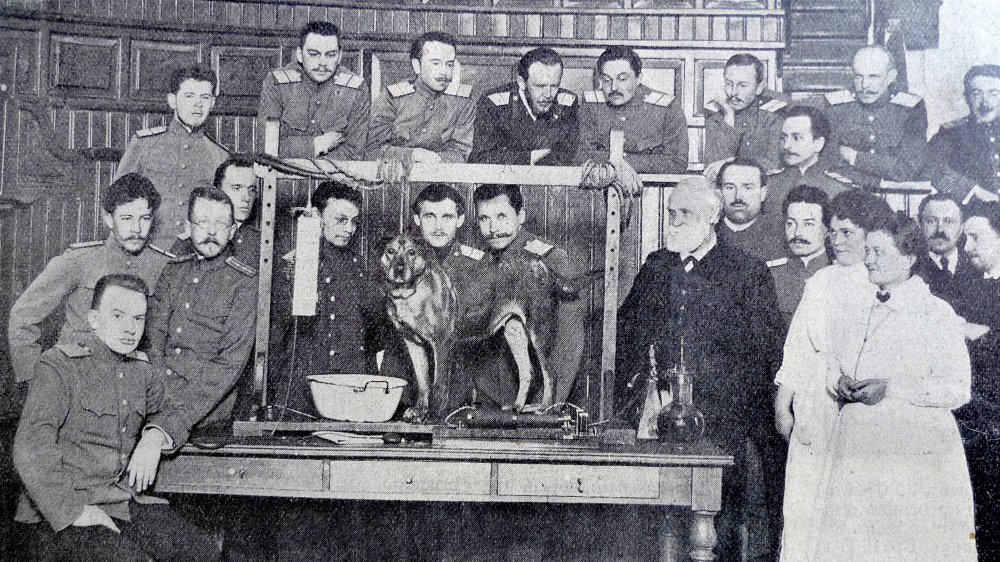The Truth About Pavlov And His Dogs
Nobel Prize-winning physiologist Ivan Pavlov was a barking mad scientist. He conducted groundbreaking and sometimes heartbreaking research. He also had a ferocious temper. A grad student working at one of Pavlov's labs recalled him having "angry days" where "there was no telling what would happen." He screamed, flew into rages, and berated coworkers for "sloppiness" or "simply for being in the wrong place at the wrong time." So just imagine the rabidness Pavlov would have unleashed if someone had told him that his most famous study would mostly be misremembered.
You may have learned that Pavlov discovered "conditioned reflexes," also known as Pavlovian responses, by conditioning dogs to salivate at the sound of a bell. But that probably wouldn't ring true to Pavlov, since that wasn't what he was doing at all. In fact, almost everyone describes the iconic dog study incorrectly. To quote Johns Hopkins Magazine, "Everything we know about Pavlov is wrong." Here's the fascinating and occasionally ugly truth about Ivan Pavlov and his dogs.
Pavlov's god
Born in the Russian village of Ryazan in 1849, Ivan Pavlov came from a family known for "iron health" and failed priests named Ivan. Per biographer Daniel Todes, Pavlov had two uncles named Ivan, and both got defrocked. One uncle was an alcoholic brawler with a "Herculean constitution." His preferred version of laying on of hands involved wrecking fools in village-wide fights. The other Uncle Ivan was a hard-drinking prankster who removed corpses from coffins and made them "[roam] the graveyard in white robes." Their brother Petr also became a priest, yet still fathered Ivan the physiologist.
Pavlov tried to follow in Petr's footsteps. According to Todes, Pavlov went to a theological school and then enrolled in seminary. But in a stroke of earthly intervention, the '60s became a period of radical changes in Russia. After Tsar Alexander II emancipated the country's roughly 23 million serfs in 1861, intellectuals started discussing progressive politics and science, and it stopped Pavlov in his tracks. His religious views evolved, thanks partly to Charles Darwin, according to PBS. Influenced by people like literary critic D. I. Pisarev and the father of Russian physiology, Ivan Sechenov, Pavlov decided to leave theology behind. Instead, he studied science at St. Petersburg University and immersed himself in physiology.
Despite his now-avowed atheism, Pavlov could relate to believing in a higher power. Writing to his future wife, Serafima Vasilievna Karchevskaya, he calls science "a kind of God, before whom I reveal everything, before whom I discard wretched worldly vanity."
Pavlov: mad scientist and infuriating husband
Pavlov's lack of belief was a personal choice that shouldn't have affected anyone around him. Yet because of his self-importance, his wife Serafima abstained from praying, fasting, and church just to please him, according to author Daniel Todes. That wasn't her only sacrifice.
Before marrying in 1881 the couple vowed to live as equals and serve humanity, but Pavlov was often self-serving. Serafima, an award-winning student with a passion for literature and religion, discussed her faith with her friend and literary idol, Fyodor Dostoevsky, and dreamed of writing a novel. But her book took a backseat to helping Pavlov focus on his work. In their early years together they often lived apart due to poverty. Nonetheless, Pavlov dragged his feet while completing his doctoral thesis and remained stuck in a low-paying job. He didn't want his wife working outside the home, so when she spent a year teaching at a schoolhouse, she lived in it.
During Serafima's first pregnancy, Pavlov forced her to "exercise rigorously." She later miscarried, and they blamed overexertion. Often volatile, Pavlov wrote spiteful letters when his temper erupted. He once suggested that sending Serafima a kiss would be "repulsive" because he hadn't heard from her in 10 days. Turns out her village was flooded. Adding injury to his many insults, he cheated on her.
We've been conditioned to misunderstand Pavlov
Ivan Pavlov's Nobel Prize bio says he "[created] a science of conditioned reflexes." Also known as "conditioned responses" and "Pavlovian responses," these are learned reactions to a stimulus that become automatic. Almost without fail, conditioned reflexes are viewed through through the lens of behaviorism, which takes a reductionist approach to studying animals that eliminates mental states from the equation. As the father of behaviorism, John Watson, put it, the "behavior of animals can be investigated without appeal to consciousness." Simply Psychology, a globally popular resource for schools and universities, explicitly couches the concept of conditioned responses "in behaviorist terms."
Sounds complicated, but basically, if Pavlov were still alive to see how people discuss his canine research, he'd probably play dead just so he could roll over in his play-grave. Johns Hopkins Magazine recaps painstaking research by medical historian Daniel Todes that reveals Pavlov didn't think of himself as "training" on or "conditioning" dogs to respond a specific way to a stimulus. He didn't call the reaction a "conditioned reflex." The specific wording he used in Russian translates to "conditional reflex," which reflects the subjective context of the dogs. While he wanted to investigate mental states objectively, Pavlov insisted that individual dogs had distinction personalities, referring to them as lazy, greedy, cowardly, and other insults in his lab notes. He saw dogs as a way to gain insight into the human mind.
Pavlov's most famous study didn't ring a bell
Ivan Pavlov and bell-induced dog drool are mentioned together so reflexively that it's almost become a Pavlovian meta-joke. Simply Psychology says it all started in the 1890s when Pavlov noticed that dogs' mouths watered when they heard the footsteps of a lab (as in laboratory, not Labrador) assistant who served them meat powder. So Pavlov played a sound at meal time and tracked their reaction. The site writes that the dogs "learned to salivate at the sound of a bell," which became the classic example of "classical conditioning." Over and over all around the world, people have repeated that bell claim.
For instance, when a biological intelligence expert in Australia trained a pea plant to grow toward a fan that blew when blue light (i.e. plant food) was shined, she specifically likened it to Pavlov's dog bell and described the finding as "disturbing." So she might be uber-disturbed to learn that Pavlov wasn't a fan of using bells in his experiments. According to Psychology professor Stephen Black, Pavlov mentioned in a lecture that he tried to employ the "violent ringing of a bell" but considered it inadequate. Johns Hopkins Magazine explains that it was too imprecise for a controlled experiment. Instead, Pavlov relied on other stimuli like a buzzer, a lamp flash, a whistle, something called a "hooter," and most of all a metronome.
Pavlov's fistulas
Pavlov wont the Nobel Prize in 1904, even if there were no bells involved. But Pavlov might have gotten no prize at all if it weren't for a fur trapper with a big old hole in his belly. As Live Science details, in 1822, 19-year-old Alexis St. Martin got blasted in the abdomen by another fur trapper's gun. Army doctor William Baumont performed "several antiseptic- and anesthesia-free surgeries." St. Martin got sick of going under the knife (as you would in those circumstances), so he was left with a fistula which UCLA Health defines as "an abnormal connection" between two body parts created by a "tunnel-like hole." St. Martin's fistula connected his stomach to the outside world, enabling Beaumon to observe the workings of his digestive system.
Per the journal Physiology, Baumant's fistula research served as the foundation for Pavlov's work. Like Beaumant, Pavlov was a surgeon and a brilliant one at that. He created a so-called gastric pouch, using a segment of intestine to produce a stomach fistula like St. Martin's. He also invented operations that made fistulas in dogs in order to perform so-called "sham feedings." This involved making holes is dogs esophaguses so food would fall out before reaching the belly. This allowed Pavlov to collect lots of uncontaminated gastric juices while a dog chewed and swallowed food for hours without getting full.
Pavlov's dog juice got turned into stomach medicine
There's something inherently upsetting about the thought of surgically inserting tunnels in the bodies of healthy dogs so that food will fall out of their throats while they try to eat. But Pavlov made a killing off of it. To be clear, he didn't kill the dogs. The journal Physiology notes that he kept his canines nourished by administering liquid through the fistulas in their bellies. Oxford University Press clarifies that Pavlov "more than doubled the budget for his" laboratories by selling some of the gastric juices he extracted from dogs as medicine for indigestion.
As it turns out, gastric juices contain a chemical called pepsin that can help relieve dyspepsia, a chronic form of indigestion. Before Pavlov started sticking fistulas in dogs, pepsin was obtained in an impure form. Food and saliva tainted the taste and reduced the effectiveness of pepsin-based medicines. But the advent of Pavlov's fistula-based gastric pouch and esophagostomy (fistula in the esophagus) created a way to take unadulterated samples. While dog pepsin proved both lucrative and effective, it was slow to catch on as a dyspepsia remedy because Pavlov preferred to reserve it for research, and many patients preferred not to take medication made from a canine's stomach fluids.
Pavlov intentionally traumatized dogs and cats
As detailed in Animal Madness, Pavlov's research went far beyond making canine's mouths water. Some might say it went too far. The famed physiologist found inspiration in the often infamous psychoanalyst Sigmund Freud. Specifically, he was drawn to Freud's work on neuroses and decided to study psychological suffering in dogs. In 1914, he embarked on a series of experiments that involved electroshocking a dog's hip while it ate. Over time, that triggered salivation. But then an experimenter would shock other body parts, causing the canine subject to become increasingly distressed.
Dogs subjected to this treatment began to vacillate between aggression and unresponsiveness. The Annual Review of Physiology cites an instance in which a "hitherto quiet dog began to squeal in its stand, kept wriggling about," and even "bit through the tubes connecting the animal's room with the observer's." It lashed out fiercely when being led to the experimental room. He didn't limit this psychological torture to dogs. He also shocked the tail of a hungry cat while it ate mice. The cat spat out its meal and for weeks would become "scared and immobile, her heart racing" at the mere sight of a mouse. Pavlov found that such "experimental neurosis are usually permanent," lasting months or even years.
Pavlov and his mistress tried to turn dogs into alcoholics
When it came to his love life, Pavlov was a dog in the least loyal sense of the word. The man's true best friend was his wife, Serafima, who, as author Daniel Todes notes, was so devoted to Pavlov's his happiness and success that she stopped practicing her faith and structured her life to meet his desires. Unfortunately, his desires also included his doctoral student, Maria Petrova. The Pennsylvania Gazette reports that Petrova entered the picture when Pavlov was 63-years-old. By that point, he was already a Nobel laureate, the first in Russian history, per the American Physiology Association. But instead of resting on his laurels, he got busy with Petrova.
The whole dynamic screamed, "awkward," partly because Pavlov was prone to screaming at people. Both he and Petrova were married, and she was roughly 25 years his junior. Pavlov's wife knew about the indiscretions, as did his colleagues. The folks at the lab didn't take kindly to the affair, and Petrova received hate mail, which she suspected came from a jealous former supervisor who wanted Pavlov for herself. In addition to screwing each other, the lovers screwed pooches over by making them neurotic, neutering them, and giving them booze during research collaborations. As Todes details, one dog reportedly went "mad" and was classified as a "sensitive schizoid." Another was judged to have exhibited symptoms similar to "an alcoholic's delusions of persecution."
Pavlov bared his fangs at Communism
As an adolescent Pavlov witnessed the radical restructuring of Russian society when Tsar Alexander II did away with serfdom. As a 68-year-old man he witnessed another restructuring when Bolsheviks did away with Tsars. According to the Pennsylvania Gazette, the proto-Soviets seized his Nobel Prize money and gold medals he received for stellar research. The Bolshevik uprising robbed Pavlov of his son Viktor, who attempted to join the opposing White Army but died of typhoid during the journey. Pavlov's brother Sergei committed the sin of being a priest after the Bolshevik takeover and was placed in a labor camp where he died.
Russia's civil war was hell for Pavlov's dogs, who found themselves dying of hunger. Angry and grief-stricken, he directed his bile at the Bolsheviks. But as much as he despised them, they seemed to adore him. The Nobel Foundation notes that in 1921, Vladimir Lenin issued a special decree honoring the physiologist for his contributions to science. Per Britannica, Lenin wanted to supply him with food rations fit for an "honored communist." But Pavlov refused to let sleeping dogmas lie. He refused the food despite risking starvation. He tried to secure permission to leave the country. In 1924, Pavlov gave a public lecture where he called the Russian Revolution the result of a "breakdown" in the human "brain machine." In 1927 he declared that he was ashamed to be a Russian.
Pavlov's mice
PBS says that Charles Darwin was instrumental turning Pavlov from a would-be priest into one of the greatest scientists of all time. But Darwin wasn't the only evolutionist who shaped his beliefs. Pavlov also harbored Lamarckian ideas. As UC Berkeley elaborates, botanist turned invertebrate expert Jean Baptiste Lamarck argued that the origin of species was partly habit-based. In this view, when an animal adopts a behavior to survive in its environment, the traits that develop through repetition can be passed down to offspring. So if a giraffe kept stretching its neck to reach leaves, its body would adapt by lengthening the neck. This longer neck, produced through habit rather than inborn traits, would be inherited by baby giraffes.
Pavlov thought animals could inherit their parents' learned habits. This would be tantamount to the baby giraffe inheriting the neck-stretching behavior instead of the longer neck. Advances in Genetics says he tested this theory on mice by conditioning them to associate food with "the ringing of a bell" (which, again, might not have actually been a bell) and then measuring how long it took future generations to do likewise. In 1923, he reported his preliminary findings while visiting the U.S. The original generation of mice needed 300 repetitions. The next generation needed only 100. The third took 30. The fourth generation took 10 and the fifth took five. Strikingly, two independent research teams corroborated his results.
Pavlov's physiology factory
Pavlov wielded enormous academic influence during the Soviet era. The Nobel Foundation claims that he had carte blanche to take his research in any direction he wished. He became the director of a sophisticated physiology program, which the the journal Physiology describes as a kind of precursor to modern fellowship programs in clinical subdisciplines. He arguably became the Henry Ford of physiology, engineering what Daniel Todes termed a "physiology factory." Pavlov turned students and assistance into educated cogs in a well-oiled science machine. They produced data efficiently and prolifically, yielding numerous publications that advanced their field. Pavlov chose and tweaked research topics and reviewed the data for publication. His factory approach may have served as a template for modern research programs in the U.S.
Ivan Pavlov worked himself to the bone until he became bones himself. Per Biography, he died of double pneumonia in 1936. According to biographer Daniel Todes, at the time of his passing he was crafting two manuscripts. One touched on "the relationship of science, Christianity, Communism, and the human search for morality and certainty." The other was to be a revision of his theory of conditional reflex. Unfortunately, he didn't finish them before his deadline.
